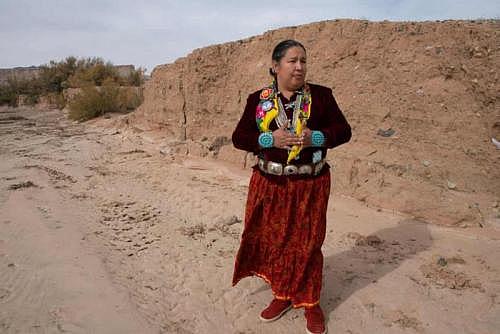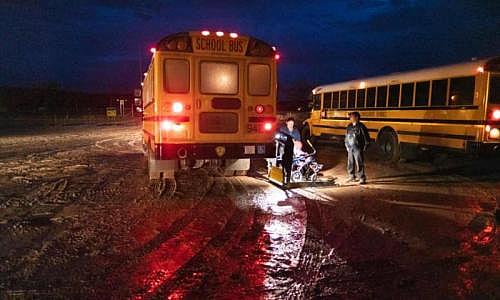Dire streets: Muddied roads and broken promises on the Navajo nation
This story was produced as a project for the 2018 National Fellowship.

A school bus on the unpaved Indian service route 5010 near Sanostee. The seven-mile corridor connects as many as 2,500 residents to the outside world – or denies them access altogether.
(Don J Usner/Searchlight New Mexico)
Sharon Begay knows this road by heart.
The 43-year-old mother of two has spent a lifetime memorizing the jagged surface and thuggish boulders that define Indian service route 5010. Locals just call it “the road” and gauge distances with landmarks: windmills, S-curves, a water tower covered with graffiti that once served as the town’s main source of gossip.
It’s an unpaved byway in the Sanostee chapter of the Navajo nation that feeds a network of unnamed dirt roads, serving hundreds of families in the shadows of the Chuska mountains. Generations of Begay’s family have herded sheep along this road; as a child she traveled it by horseback, alongside her father.
But this road also broke Begay’s heart.
On a rainy day in the winter of 2004, her father collapsed in front of the cluster of small, wood-frame homes where she and her extended family still live. The energetic man of 75 had just arrived home from tending the family’s 60-odd head of sheep. He got out of his truck and crumpled to the ground. The rain that day was relentless, the mud impenetrable.
“It took three ambulances to finally get him,” Begay said. “The first ambulance got stuck in the mud, then the second got stuck.” Nearly four hours passed before the third ambulance reached him. He died in the hospital shortly afterward.
“I’ve always wondered whether he could have lived longer, if the road was better,” Begay said. “I’ll wonder that all my life.”
Nearly everyone in the Sanostee chapter has a story about Indian service route 5010, a seven-mile corridor that connects as many as 2,500 residents to the outside world – or denies them access altogether.
“During winter or early spring, life really revolves around the condition of the road,” the Sanostee chapter president, Frank Smith, said. “People leave early in the morning when the ground is still frozen, and they can’t come home until it’s frozen again. Sometimes, people can’t leave home for a week at a time, or longer.”
Rain or snow transforms the dirt into mud so thick that 15-ton school buses get mired up to their axles. School districts cancel classes. People can’t get to work or reach the main highway, US 491, to access grocery stores – the nearest of which is 40 miles north.
The chapter’s Authorized Local Emergency Response Team (Alert) routinely dispatches volunteers to check on the most vulnerable residents, delivering food, wood and hay for livestock. The mud bogs derail ambulances or delay their arrival for hours or even days. In the worst cases, aid comes by helicopter.
“This has been forever a problem,” said LaVerda Washburn, a member of Sanostee’s road committee, a group formed two years ago to address Route 5010. “Every time it rains between November and March, we pray. The road grabs people and doesn’t let go. It has a hold on all of us.”
Infrastructure weak
At about 27,000 sq miles, or roughly the size of West Virginia, the Navajo nation is the country’s largest Indian reservation. It is also one of the most rural pieces of America, spanning parts of three western states.

Since time immemorial, the Navajo have laid claim to these stark landscapes, where daily life and survival are intimately tied to the earth, to changing seasons, and to the traditions passed from one generation to the next. Although collective oral histories stretch back thousands of years, most family stories begin in 1868 – the year the Navajo signed a treaty with the United States that ended their incarceration at Bosque Redondo and allowed them to return to their ancestral homeland.
In addition to creating a Navajo reservation, the treaty spelled out the responsibilities of the federal government. In exchange for peace and the relinquishment of Navajo claims to land outside the reservation, the government pledged to provide a school house and a teacher for every 30 students.
The promises were essentially worthless. The federal government and its Bureau of Indian Affairs (BIA) have historically failed to furnish even the most basic infrastructure necessary to operate local schools. Among the most obvious failures: federal agencies refused to construct roads that would allow children to ride a bus to schools near their home. Instead, they were sent to distant boarding schools that stripped them of their Native language and culture.
A 1969 congressional report excoriated the BIA for refusing to create basic roadways that would allow Native American families to stay intact and access an education. Not much has changed in the last 50 years. With a population hovering around 400, Sanostee is a tight-knit community. Yet one rainstorm can cut the chapter in pieces, washing out bridges and culverts and stranding residents.
Amber Kanazbah Crotty, who represents Sanostee on the Navajo nation council, called the lack of infrastructure an abuse of human rights and a violation of the federal government’s treaty obligations.
“In denying us roads, the federal government has denied us access to basic human rights like education and healthcare,” she said.
Malign Neglect
For Cindy Theodore, transportation coordinator for the Central Consolidated School District (CCSD), watching the weather and predicting road conditions is a full-time job. The nearly 3,000 sq mile school district in rural north-west New Mexico serves a predominantly Navajo student population, and 95% of its bus routes are dirt.

The district implements a system of “bad weather stops” for as many as 15 days a year. That means schools buses don’t travel their full route because of rain, snow or mud – forcing parents to deliver their children to alternate locations, or to keep them home until the roads dry out.
“If we’re expecting weather coming in, I leave the bus yard at about 4am and go out to drive the route to see if it’s safe,” Theodore said.
Every day of missed school affects students’ academic performance, said Terrian Benn, CCSD’s interim superintendent. New Mexico consistently ranks last in the country in categories like quality of education and overall child wellbeing, and Benn believes poor roads are partly to blame.
In the last decade, the road crisis in Indian country has been the topic of at least eight US Senate hearings, during which New Mexico’s congressional delegation has lambasted the federal government and the BIA for their neglect of tribal transportation systems.
Tires that bind
Of the 11,600 miles of road on the Navajo nation, 9,000 miles are dirt, according to Garret Silversmith, director of the Navajo division of transportation.
NDOT operates with a yearly budget of about $60m, money that comes from the Federal Highway Administration, fuel excise taxes and the tribe’s general operating fund. Of that, more than $5m per year goes to blading – or grading – unpaved roads. Blading costs $750 a mile, and it lasts only until the next big rain. The $5m budget covers blading for 15 miles of roads a chapter per quarter.
“If you add that up, it’s 60 miles per chapter per year,” Silversmith said. “So we can only focus on the highest priority routes. Because blading just smooths the surface, we end up blading the same 15 miles four times every year.”

The cost for permanent improvements is astronomical. According to the most recent estimates, pavement costs $3m a mile, while cheaper alternatives such as double chip seal or gravel cost $350,000 and $250,000 a mile, respectively. Just putting down gravel on all the Navajo nation’s roads would cost more than $2bn.
The BIA holds the right of way on about half of the dirt roads on the Navajo nation. Searchlight New Mexico made repeated attempts to interview the director of the BIA’s Navajo regional office – without success.
Lost in space (and time)
Now nearing 70, Emil Benally and his wife, Jean, are raising their four-year-old great-grandson on the small farm that has sustained six generations of his family.
That farm, nestled deep in a secluded canyon and accessible only by way of a winding, rugged lane, marks one end of Route 5010. Before it washed out years ago, the road connected Sanostee to Toadlena and Two Grey Hills, communities to the south that are known for their historic trading posts. Today, 5010 dead-ends just past Benally’s house, seven miles from the nearest paved road.
“When I was a toddler, my grandparents told me stories about the land,” he said. “At one time, we had cattle here, enough water for farming, even an orchard.”
Back then, going to town meant hitching a wagon to a team of horses, traveling up the steep incline and weaving around the boulder-fringed hairpin turns. In the mid-1950s, Benally’s mother dropped him off at a boarding school 10 miles away – too far for the daily commute by wagon. As a teen, Benally walked seven miles each way to a summer employment program.
“The road has always been difficult,” Benally said. “Every year there were times in the winter or spring when the mud or snow was too deep to get out.”
Still, Benally gave up a career as a silversmith in Albuquerque to raise his own children in the canyon. He learned to plan ahead, to stock up food and firewood, and to rely on his own resourcefulness to survive.
He hopes his great-grandson won’t have to battle for a road all of his life, as so many Navajo have done.
“If you live in a city with paved roads, you can’t even imagine this,” Benally said. “It’s like we’re lost somewhere in the past.”
[This story was originally published by Searchlight New Mexico and co-published in The Guardian.]


